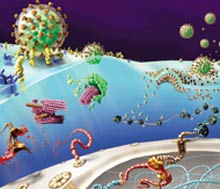The rat species is involved in the study of AIDS medicines
Whether rats and rodents are resistant to HIV is a problem that has led AIDS researchers for a long time to find a small animal suitable for studying the disease.
Recently, scientists have demonstrated that mutated genetic mice withstand the effects of HIV, may be useful in finding AIDS-specific drugs.
Many research groups have been working hard to study the immunity of rats through transplants into their bodies that can harm humans. But this process has become increasingly difficult.

Picture depicting the life cycle of HIV
(Photo: sciencemag.org)
Four years ago, a group of researchers, including microbiologist Oliver Keppler, implanted into their bodies two cell nuclei that the virus used to attack the human immune system, called CD4 and CCR5. But the HIV virus did not replicate vigorously in these animals' bodies as it does humans, which proves that the effect of viruses on low-level animals is slower for humans.
Known as a inhibition of self-replicating processes, that is the purpose of preparing drugs against HIV. Due to these limitations, this research sample is also rarely taught in schools to clarify how the HIV virus causes disease. Keppler, a lecturer at the University of Heidelberg in Germany, and his research team are trying to add some new genes to these genetic structures to overcome remaining obstacles. Keppler said: " I don't think this sample will be right in all cases ."
During that time Keppler's group decided to find out how this rat could slow HIV attack into cells, before they begin the reprinting process.
Two drugs tested are two approved types. They are T-20 (preventing viral entry into cells) and Sustiva (slowing the metabolism from viral RNA to the cell DNA). And the results show that with both drugs, the number of immune cells that can be obtained when studying in this mouse and in humans is completely equivalent.
According to Robert Gallo (head of the Bantimo, Garyland Institute of Anthropology), he thinks this is a good start. He was also the first to open a laboratory to study the subject of HIV and AIDS. He said: ' People want a sample of a small creature '. It's a good thing.
However, according to Nathaniel Landau (who created the HIV-infected mouse under the Department of Medicine at New York University), the question is whether pharmaceutical companies use it? Keppler explained that he contacted many pharmaceutical companies, including a large pharmaceutical company.
TTCT
- Drug for HIV / AIDS treatment: 1 USD / tablet
- There are medicines for AIDS treatment for children
- Medicines for HIV / AIDS treatment
- India helps Vietnam produce drugs to treat HIV / AIDS
- Barzil reduced the price of AIDS medicines
- AIDS nightmare in Russia
- Australia claims AIDS is no longer a public health issue
- Detection of peptides in the blood inhibits HIV / AIDS virus
- The new vaccine has the ability to prevent HIV / AIDS virus
- Hearing aids control thinking
- To prevent HIV / AIDS be the waves ...
- Chimpanzees can also die from AIDS
 Green tea cleans teeth better than mouthwash?
Green tea cleans teeth better than mouthwash? Death kiss: This is why you should not let anyone kiss your baby's lips
Death kiss: This is why you should not let anyone kiss your baby's lips What is salmonellosis?
What is salmonellosis? Caution should be exercised when using aloe vera through eating and drinking
Caution should be exercised when using aloe vera through eating and drinking